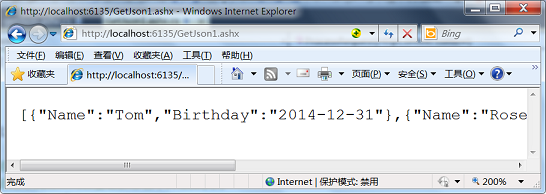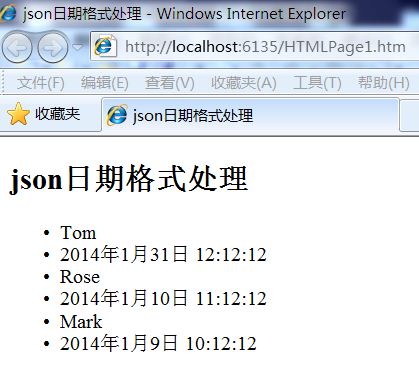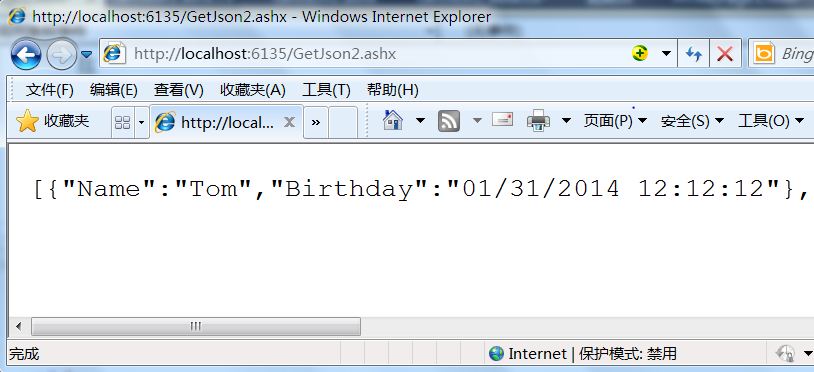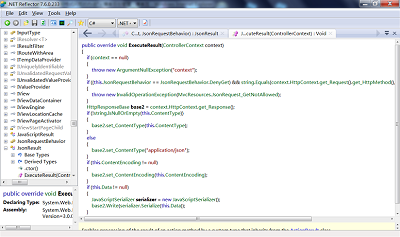Home >Backend Development >C#.Net Tutorial >Detailed explanation of four solutions to Json date format problems
Detailed explanation of four solutions to Json date format problems
- 高洛峰Original
- 2018-05-11 13:26:133900browse
This article mainly introduces four solutions to the Json date format problem. It is very good and has reference value. Friends who need it can refer to it
Sometimes it is needed during development Return json format data from the server. If there is DateTime type data in the background code, it will be represented by a long number after serialization using the system's own tool class. The date data is as follows:
//设置服务器响应的结果为纯文本格式
context.Response.ContentType = "text/plain";
//学生对象集合
List<student> students = new List<student>
{
new Student(){Name ="Tom",
Birthday =Convert.ToDateTime("2014-01-31 12:12:12")},
new Student(){Name ="Rose",
Birthday =Convert.ToDateTime("2014-01-10 11:12:12")},
new Student(){Name ="Mark",
Birthday =Convert.ToDateTime("2014-01-09 10:12:12")}
};
//javascript序列化器
JavascriptSerializer jss=new JavascriptSerializer();
//序列化学生集合对象得到json字符
string studentsJson=jss.Serialize(students);
//将字符串响应到客户端
context.Response.Write(studentsJson);
context.Response.End();</student></student>
The running result is:

The corresponding birthday of Tom "2014-01-31" becomes We got 1391141532000, which is actually the number of milliseconds since January 1, 1970; 1391141532000/1000/60/60/24/365=44.11 years, 44+1970=2014 years, this method can get the year, month, day, hour and minute seconds and milliseconds. This format is a feasible representation but not a friendly format that ordinary people can understand. How to change this format?
Solution:
Method 1: Use the Select method## to change the date format on the server side #Or LINQ expression is converted and sent to the client:
using System;
using System.Collections.Generic;
using System.Web;
using System.Web.script.Serialization;
namespace JsonDate1
{
using System.Linq;
/// <summary>
/// 学生类,测试用
/// </summary>
public class Student
{
/// <summary>
/// 姓名
/// </summary>
public String Name { get; set; }
/// <summary>
/// 生日
/// </summary>
public DateTime Birthday { get; set; }
}
/// <summary>
/// 返回学生集合的json字符
/// </summary>
public class GetJson : IHttpHandler
{
public void ProcessRequest(HttpContext context)
{
//设置服务器响应的结果为纯文本格式
context.Response.ContentType = "text/plain";
//学生对象集合
List<Student> students = new List<Student>
{
new Student(){Name ="Tom",Birthday =Convert.ToDateTime("2014-01-31 12:12:12")},
new Student(){Name ="Rose",Birthday =Convert.ToDateTime("2014-01-10 11:12:12")},
new Student(){Name ="Mark",Birthday =Convert.ToDateTime("2014-01-09 10:12:12")}
};
//使用Select方法重新投影对象集合将Birthday属性转换成一个新的属性
//注意属性变化后要重新命名,并立即执行
var studentSet =
students.Select
(
p => new { p.Name, Birthday = p.Birthday.ToString("yyyy-mm-dd") }
).ToList();
//javascript序列化器
JavascriptSerializer jss = new JavascriptSerializer();
//序列化学生集合对象得到json字符
string studentsJson = jss.Serialize(studentSet);
//将字符串响应到客户端
context.Response.Write(studentsJson);
context.Response.End();
}
public bool IsReusable
{
get
{
return false;
}
}
}
}Select method reprojects the object collection and converts the Birthday attribute into a new attribute. Note that the attribute must be renamed after the attribute changes. The attribute name can be the same ; Here you can use the select method or LINQRun result:

Method 2:
Convert the string in "Birthday":"\/Date(1391141532000)\/" into a date object in javascript , you can delete the non-numeric characters in the Value corresponding to Birthday<!DOCTYPE html>
<html xmlns="http://www.w3.org/1999/xhtml">
<head>
<title>json日期格式处理</title>
<script src="scripts/jquery-1.10.2.min.js" type="text/javascript"></script>
<script type="text/javascript">
$(function() {
$.getJSON("getJson.ashx", function (students) {
$.each(students, function (index, obj) {
$("<li/>").html(obj.Name).appendTo("#ulStudents");
//使用正则表达式将生日属性中的非数字(\D)删除
//并把得到的毫秒数转换成数字类型
var birthdayMilliseconds = parseInt(obj.Birthday.replace(/\D/igm, ""));
//实例化一个新的日期格式,使用1970 年 1 月 1 日至今的毫秒数为参数
var birthday = new Date(birthdayMilliseconds);
$("<li/>").html(birthday.toLocaleString()).appendTo("#ulStudents"); ;
});
});
});
</script>
</head>
<body>
<h2>json日期格式处理</h2>
<ul id="ulStudents">
</ul>
</body>
</html> Running results:

$(function () {
$.getJSON("getJson.ashx", function (students) {
$.each(students, function (index, obj) {
$("<li/>").html(obj.Name).appendTo("#ulStudents");
//使用正则表达式将生日属性中的非数字(\D)删除
//并把得到的毫秒数转换成数字类型
var birthdayMilliseconds = parseInt(obj.Birthday.replace(/\D/igm, ""));
//实例化一个新的日期格式,使用1970 年 1 月 1 日至今的毫秒数为参数
var birthday = new Date(birthdayMilliseconds);
$("<li/>").html(birthday.toLocaleString()).appendTo("#ulStudents");
$("<li/>").html(obj.Birthday.toDate()).appendTo("#ulStudents");
});
});
});
//在String对象中扩展一个toDate方法,可以根据要求完善
String.prototype.toDate = function () {
var dateMilliseconds;
if (isNaN(this)) {
//使用正则表达式将日期属性中的非数字(\D)删除
dateMilliseconds =this.replace(/\D/igm, "");
} else {
dateMilliseconds=this;
}
//实例化一个新的日期格式,使用1970 年 1 月 1 日至今的毫秒数为参数
return new Date(parseInt(dateMilliseconds));
}; The above extended method toDate may not be reasonable or powerful enough, and can be modified as needed.
Method 3:
You can choose some third-party json tool classes, many of which have already dealt with date format issues, commonjson serialization and deserialization tool libraries are:
1.fastJSON.2.JSON_checker.
3.Jayrock.
4.Json.NET - LINQ to JSON.
5.LitJSON.
6.JSON
for .NET.7.JsonFx.
8.JSONSharp.
9.JsonExSerializer.
10 .fluent-json
11.Manatee Json
using System;
using System.Collections.Generic;
using System.Web;
using LitJson;
namespace JsonDate2
{
using System.Linq;
/// <summary>
/// 学生类,测试用
/// </summary>
public class Student
{
/// <summary>
/// 姓名
/// </summary>
public String Name { get; set; }
/// <summary>
/// 生日
/// </summary>
public DateTime Birthday { get; set; }
}
/// <summary>
/// 返回学生集合的json字符
/// </summary>
public class GetJson : IHttpHandler
{
public void ProcessRequest(HttpContext context)
{
//设置服务器响应的结果为纯文本格式
context.Response.ContentType = "text/plain";
//学生对象集合
List<Student> students = new List<Student>
{
new Student(){Name ="Tom",Birthday =Convert.ToDateTime("2014-01-31 12:12:12")},
new Student(){Name ="Rose",Birthday =Convert.ToDateTime("2014-01-10 11:12:12")},
new Student(){Name ="Mark",Birthday =Convert.ToDateTime("2014-01-09 10:12:12")}
};
//序列化学生集合对象得到json字符
string studentsJson = JsonMapper.ToJson(students);
//将字符串响应到客户端
context.Response.Write(studentsJson);
context.Response.End();
}
public bool IsReusable
{
get
{
return false;
}
}
}
}The running results are as follows:

var date = new Date("01/31/2014 12:12:12");
alert(date.toLocaleString());The client code is as follows:
$(function () {
$.getJSON("GetJson2.ashx", function (students) {
$.each(students, function (index, obj) {
$("<li/>").html(obj.Name).appendTo("#ulStudents");
var birthday = new Date(obj.Birthday);
$("<li/>").html(birthday.toLocaleString()).appendTo("#ulStudents");
});
});
});
var date = new Date("01/31/2014 12:12:12");
alert(date.toLocaleString());
Method 4:
这点文字发到博客上有网友提出了他们宝贵的意见,我并没有考虑在MVC中的情况,其实MVC中也可以使用handler,所以区别不是很大了,但MVC中有专门针对服务器响应为JSON的Action,代码如下:
using System;
using System.Web.Mvc;
namespace JSONDateMVC.Controllers
{
public class HomeController : Controller
{
public JsonResult GetJson1()
{
//序列化当前日期与时间对象,并允许客户端Get请求
return Json(DateTime.Now, JsonRequestBehavior.AllowGet);
}
}
}运行结果:
下载一个内容为Application/json的文件,文件名为GetJson1,内容是"\/Date(1391418272884)\/"
从上面的情况看来MVC中序列化时并未对日期格式特别处理,我们可以反编译看源码:
Return调用的Json方法:
protected internal JsonResult Json(object data, JsonRequestBehavior behavior)
{
return this.Json(data, null, null, behavior);
}
this.Json方法
protected internal virtual JsonResult Json(object data, string contentType, Encoding contentEncoding, JsonRequestBehavior behavior)
{
return new JsonResult { Data = data, ContentType = contentType, ContentEncoding = contentEncoding, JsonRequestBehavior = behavior };
}JsonResult类ActionResult类的子类,ExecuteResult方法:

从上面的代码中不难看出微软的JsonResult类仍然是使用了JavascriptSerializer,所以返回的结果与方法一未处理时是一样的,要解决这个问题我们可以派生出一个新的类,重写ExecuteResult方法,使用Json.net来完成序列化工作,JsonResultPro.cs文件的代码如下:
namespace JSONDateMVC.Common
{
using System;
using System.Web;
using System.Web.Mvc;
using Newtonsoft.Json;
using Newtonsoft.Json.Converters;
public class JsonResultPro : JsonResult
{
public JsonResultPro(){}
public JsonResultPro(object data, JsonRequestBehavior behavior)
{
base.Data = data;
base.JsonRequestBehavior = behavior;
this.DateTimeFormat = "yyyy-MM-dd hh:mm:ss";
}
public JsonResultPro(object data, String dateTimeFormat)
{
base.Data = data;
base.JsonRequestBehavior = JsonRequestBehavior.AllowGet;
this.DateTimeFormat = dateTimeFormat;
}
/// <summary>
/// 日期格式
/// </summary>
public string DateTimeFormat{ get; set; }
public override void ExecuteResult(ControllerContext context)
{
if (context == null)
{
throw new ArgumentNullException("context");
}
if ((this.JsonRequestBehavior == JsonRequestBehavior.DenyGet) && string.Equals(context.HttpContext.Request.HttpMethod, "GET", StringComparison.OrdinalIgnoreCase))
{
throw new InvalidOperationException("MvcResources.JsonRequest_GetNotAllowed");
}
HttpResponseBase base2 = context.HttpContext.Response;
if (!string.IsNullOrEmpty(this.ContentType))
{
base2.ContentType = this.ContentType;
}
else
{
base2.ContentType = "application/json";
}
if (this.ContentEncoding != null)
{
base2.ContentEncoding = this.ContentEncoding;
}
if (this.Data != null)
{
//转换System.DateTime的日期格式到 ISO 8601日期格式
//ISO 8601 (如2008-04-12T12:53Z)
IsoDateTimeConverter isoDateTimeConverter=new IsoDateTimeConverter();
//设置日期格式
isoDateTimeConverter.DateTimeFormat = DateTimeFormat;
//序列化
String jsonResult = JsonConvert.SerializeObject(this.Data,isoDateTimeConverter);
//相应结果
base2.Write(jsonResult);
}
}
}
}使用上面的JsonResultPro Action类型的代码如下:
public JsonResultPro GetJson2()
{
//序列化当前日期与时间对象,并允许客户端Get请求,注意H是大写
return new JsonResultPro(DateTime.Now,"yyyy-MM-dd HH:mm");
}运行结果:
"2014-02-03 18:10"
这样就可以完全按自己的意思来设置日期格式了,但需要注意日期格式如平时的Format是有区别的,如这里表示时间的H如果大写表示24小时制,如果小写表示12小时制。另外还有几个问题要问大家:
1、通过Reflector反编译得到的代码中有很多变化,如属性会变成get_Request()方法的形式,不知道大家有没有更好的方法。
2、在反编译得到的代码中使用到了资源文件MvcResources.JsonRequest_GetNotAllowed,怎么在重写时也可以使用?
The above is the detailed content of Detailed explanation of four solutions to Json date format problems. For more information, please follow other related articles on the PHP Chinese website!

